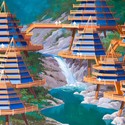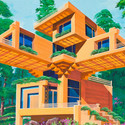originally published on Metropolis Magazine "The future of architecture, According to north Korean architect , "this interview with Nick Bonner, curator of the north Korean portion of the Korean pavilion of the Venice Biennale, focuses on the realities of architectural work in one of the most secretive countries in the world .
There is a good chance that you will never step foot in North Korea, which is the same as saying you can not. the interest in the socialist state is increasingly high, a fact reflected by an increase in tourists wanting to discover the sites and shows Pyongyang. Nick Bonner, founder of Koryo Tours, and brings visitors to the Democratic People's Republic of Korea (DPRK) for over two decades. He recently curated a small exhibition in the Korean pavilion in Venice architecture Biennale this year.
For "Utopian Tours" Bonner commissioned drawings of a North Korean architect unidentified, asking him to consider a whole new infrastructure to accommodate larger groups and more great tourists. The resulting Handdrawn illustrations are fascinating: the future of architecture, at least in North Korea is much like the future of yesterday, where tourists traveling by RV hovercraft, and workers live in shaped hotels ziggurat inspired by mountains and trees
[
Metropolis asked landscape architect trained to give us a tour inside this architecture scene of one of the most isolated countries in the world today.



 12
12
Justin Zhuang: Can you tell us about the project you've been commissioner for the Venice Biennale? Why did you specifically sought to tourism in the country
Nick Bonner: "Utopian Tours" is the main exhibition that we have provided for the Korea Pavilion [winner of the Golden Lion]. The pavilion was originally designed to provide space for both North and South Korea to hold a joint exhibition. Koryo Tours have worked in North Korea since 1993, and we use tourism to promote human engagement in North Korea.
Tourism has allowed us to visit the country more than 21 years on a monthly basis, and during that time we were able to better understand important aspects of life in the DPRK, like how urban space is used and how people interact with each other. Traveling the country on such a regular basis, and over such a long period of time, also allowed to see the changes that have taken place in the country. Our part of the exhibition is the result of the time spent in Pyongyang; it not only shows how North Korea represents the architecture as belonging to the people, but also how an architect sees the future of sustainable tourism and Korean architecture.
JZ: The illustrations are remarkable for their pictorial style. this aesthetic was intentional
NB: North Korean architects now use CAD, but they are still trained to illustrate the vision of buildings completed in painted style hand using gouache. I trained as a landscape architect in the mid-eighties, and we used techniques similar (but not as effectively). When I was a landscape architect in the late eighties, we commission artists and professional designers to make our designs in exactly the same way. Now, of course, everything is digital
JZ :. The biennial offered a glimpse of the concerns and ambitions of the architects of North Korea. Where and how are these trained architects? And what are their main reference sources
NB: The majority of architects are trained in construction and Pyongyang University of building materials in Pyongyang and all work for the government. As I already said, there is no private projects. The architect we worked with had just started working for an Asian company for a period of five years.
There are several North Korean architects who have studied abroad, especially in Paris, and this will certainly have an influence. The architects we meet are always interested in seeing contemporary architecture not only visualizations but also plans and construction methods.
JZ: How has an architecture in North Korea has developed over decades
NB: Japanese (who occupied Korea from 1910 to 1945) had a huge influence on architecture in Korea. During the Korean War (1950-1953), however, Pyongyang has been flattened and Soviet neoclassicism postwar became the dominant style. In the years 1960 and 1970 the direction changed again, and buildings with clear Korean influences and features (such as Study House Grand People on Kim Il Sung Square), or drawings that were much more modern and unique ( as distinctive rink), began to appear.
JZ: How would you describe the state of North Korea in architecture
NB: Each project in North Korea is a government project. There are, however, several foreign projects where North Korean architects were commissioned, although these are mostly war museums, monuments, etc.
The best North Korean architects working in Paektusan Architectural Institute and have very limited access to contemporary architecture. By visiting the institute, you will see a small selection of works from Fallingwater by Frank Lloyd Wright in Barcelona Mies Van Der Rohe, and a handful of modern skyscrapers. Limited exposure is not necessarily because of government censorship; there is also a shortage of books and architectural journals that could (and probably should) be sent from architecture and design institutions worldwide. When we take architectural tours-our neighbor leaves the 25 October we are always asked to bring a number of architectural books and magazines.
JZ: Is the famous Treaty of Kim Jong-Il "On Architecture" continue to exercise their influence in the north Korean community of architecture?
NB: This work is the orientation text for all North Korean Architects in how his treatise on "the art of cinema" is the final text for north Korean filmmakers. These works are sets, clear and indisputable instructions underlying the education and training of architects and north Korean filmmakers. This does not mean that all projects and architectural buildings north Koreans are identical; there is a wide variety in the style of public buildings in the DPRK, but all rendered within the limits of what is officially sponsored and considered
[1945022"Koreancontemporaryarchitecture"]
JZ: What are some of the biggest challenges faced by north Korean architects today
NB: most limiting face by north Korean architects is the lack of quality materials and knowledge of modern construction techniques. North Korean architects are limited to working with concrete and reinforcing steel bars (there is no possibility of glass curtain walls, etc.), so it is a matter of being creative with all the materials they have at their disposal.
JZ: What are some important pieces of the North Korean architecture that deserve greater recognition
NB: Pyongyang was completely rebuilt after the Korean war only three buildings were left standing in the city at the end of the conflict. It is, therefore, not just individual examples of architecture that are of interest, but also the master plan for rebuilding the city as a modern "socialist utopia" composed of government buildings monumental squat, Soviet influence, houses of brutalist style, parks and river corridors and landscaped avenues sweep of trees.
There are, however, some individual buildings great architectural merit that must undoubtedly be seen on a trip to Pyongyang:
Posting Komentar